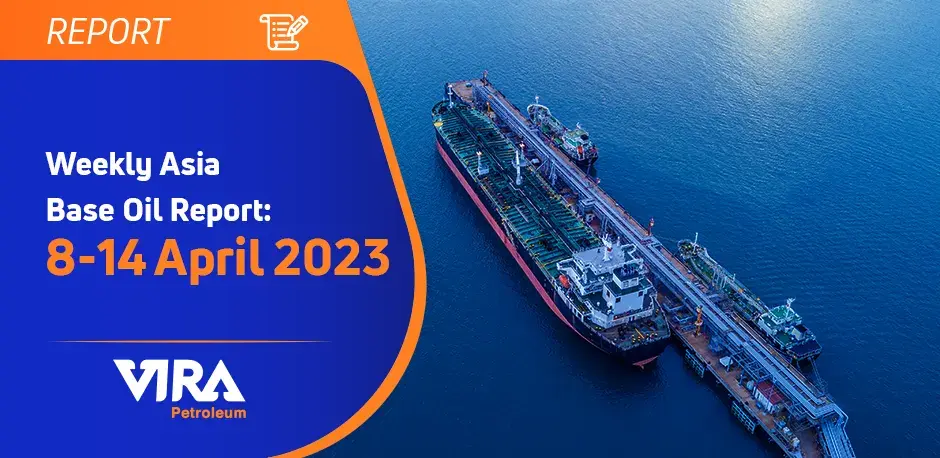Despite suppliers hoping for a surge in demand, they are satisfied with the current consumption levels and stable prices in most countries. However, the recent rise in crude oil prices has caused some pressure on the value of base oils. Nonetheless, changes in feedstock prices usually take some time to impact base oil prices. Despite this, buyers are looking to secure their supplies in anticipation of potential price hikes. Contract customers have increased the volumes they expect to receive in the upcoming weeks, while other buyers have turned to the spot market to secure their orders. This reflects the prospects of higher base oil prices in the near future.
Order : Recycled Base Oil
Base Oil Trends In Asia
Although the Chinese market has been relatively subdued in recent weeks, other countries in Southeast Asia have shown strong interest in purchasing API Group I base oils, despite the ongoing observance of Ramadan in some nations from March 22 to April 20.
As the number of Group I producers continues to decrease, demand has remained high in countries such as Singapore, Thailand, and Indonesia. However, the recent explosion and fire at an Indonesian producer’s facility may lead to a reduction in shipments. Additionally, a key refiner in Singapore will be undergoing a two-month turnaround starting in late April, which could further limit availability. Despite these challenges, buyers have been eager to secure cargoes, and some have even increased the volumes they expect to receive in the coming weeks. This has led to some price pressure, particularly as crude oil prices have risen, but producers have noted that changes in feedstock prices do not typically have an immediate effect on base oil values.
In the lubricant market, the demand for Group II base oils has been increasing as consumers opt for a cheaper alternative to Group I base oils. With the global supply of Group II base oils growing, its prices have been competitive with Group I values. The trend has led many Group I consumers to shift to Group II base oils, wherever downstream applications allowed it. The oversupply of Group I bright stock due to seasonal trends has led to a decline in bids and offers this week. Despite the shift towards Group II base oils, the demand for Group I base oils remains steady, especially in Southeast Asian markets where the number of API Group I base oil producers has been decreasing over the years.
Base Oil Trends In Thailand
In May, a Thai producer is actively seeking to export 2,000 metric tons of their product, with a shipment expected to be lifted from Sri Racha, Thailand, to Taichung, Taiwan, in the first half of the month. Additionally, another 2,000-ton cargo has been mentioned for shipment from Sri Racha to Mundra, India, in the same period. The Thai producer’s push for exports reflects their confidence in the demand for their product, as well as the ability to efficiently transport their goods to various destinations in Asia. It will be interesting to see how the market responds to these upcoming shipments and if it creates any shifts in supply and demand dynamics.
Order: Rubber Process Oil
Base Oil Trends In South Korea
Suppliers from South Korea have been actively finalizing deals with various Southeast Asian countries, leading to a tightening of spot availability in the market. Moreover, the anticipation of a turnaround at a major South Korean facility in the second quarter is expected to exacerbate the supply constraints in the region. As a result, buyers are increasingly looking to secure their base oil requirements for the upcoming months, while sellers are taking advantage of the favorable market conditions to increase prices. The situation has led to a sense of urgency in the market, with both buyers and sellers looking to secure favorable deals in the face of an uncertain supply outlook.
Demand for Group III base stocks in Southeast Asia has been on the rise, and South Korean suppliers have been quick to capitalize on this trend. In recent weeks, several South Korean cargoes have been sold to Vietnam and Indonesia, with prompt shipments ranging from 500 to 1,700 tons.
For instance, a 500-ton cargo was sold from Onsan to Ciwandan, Indonesia, while a 1,200-ton cargo was expected to be shipped from Onsan to Bangkok, Thailand, during the first week of May. Additionally, about 1,000 tons of Group III base stocks were quoted from Onsan to Ho Chi Minh, Vietnam, in mid-May, while a 1,700-ton parcel was mentioned for shipment from Onsan to Godau, Vietnam, at the end of April.
Other notable shipments include a 1,100-ton cargo expected to be shipped from Yeosu to Yokohama, Japan, in early June and a 4,000-ton lot likely to be shipped from Yeosu to Koh Sichang, Thailand, around May 5-10.
The increasing demand for Group III base stocks in Southeast Asia can be attributed to several factors, including its superior performance in automotive and industrial lubricants, lower sulfur content, and higher viscosity index compared to other base stocks. As such, it is not surprising to see South Korean suppliers taking advantage of this trend and expanding their market share in the region.
Base Oil Trends In India
Buyers in India have shown stronger demand for all grades of base oils in recent weeks, as they try to stay ahead of potentially higher prices in the near future due to the increase in crude oil and feedstock prices. This trend has been observed across the country, as buyers try to secure adequate supplies for their operations. However, the domestic production of base stocks has been somewhat insulated from these price hikes. India has been able to import Russian crude oil at a steep discount, which has allowed domestic producers to maintain competitive prices. This has been a positive development for Indian buyers who have been able to access affordable base oils without being affected by fluctuations in global crude oil prices.
There are several base oil cargoes that are set to arrive in India in the coming weeks, which includes shipments from the United States, South Korea, the Middle East, and Southeast Asia. Despite the increasing demand for base oils in India, buyers are still taking efforts to beat the potentially higher base oil prices in the coming weeks as crude oil and feedstock prices continue to strengthen. Fortunately, domestic production of base stocks in India is somewhat insulated from these price hikes since they can import Russian crude oil at a significant discount. This has allowed domestic producers to maintain competitive prices.
In discussions this week, a 16,000-metric ton cargo was the center of attention as it is set to be shipped from Houston, United States to Mumbai in early May. Additionally, a 2,000-ton cargo was mentioned for lifting in Sri Racha to West Coast India in mid-April. A 1,700-ton lot was quoted for shipment from Malacca, Malaysia, to Mumbai at the end of April, while over 5,000 tons were on the table for shipment from Singapore to Ennore, Chennai, Kolkata, and Chittagong, Bangladesh, at the end of April to the first days of May. Lastly, about 8,000 tons were expected to be shipped from Ruwais, United Arab Emirates, to West Coast India in late April.
Base Oil price In China
In recent weeks, the Chinese market has been relatively quiet as most of the country’s base oil needs are being met by domestic production. Although there are some signs of economic recovery following the pandemic, it has been uneven across various sectors. As for base oils, there have been some indications that import interest is beginning to emerge, with a few new cargoes being discussed this week. However, imported base oils are still facing difficulties in competing with domestic prices, which have been kept low due to the abundance of supply.
One of the cargoes being considered is a 1,000-ton shipment from Onsan to Tianjin, scheduled for April 21-24. Additionally, another cargo of approximately 1,500 tons, made up of two different grades, was discussed for lifting in Onsan to Tianjin in mid-May. Meanwhile, a 3,300-ton cargo from Singapore to Zhenjiang was being considered for mid-April shipment. Finally, a cargo of 1,350 tons, consisting of three grades, was being discussed for loading in Onsan and shipping to Zhenjiang at the end of May.
Despite the subdued activity, there are hopes that the Chinese market will begin to pick up as the economy continues to recover. In the meantime, the market remains cautious and is monitoring developments closely.
Base Oil price In Asia
The prices for spot base oil in Asia remained mostly stable, with the exception of Group I bright stock which saw a small decrease due to an increase in supply. The following price ranges are based on discussions, bids, offers, deals, and widely regarded published prices in the region.
Ex-tank prices in Singapore remained steady from the previous week. Spot prices for the Group I SN 150 base oil grade were assessed at $920/t-$950/t, while SN 500 base oil was at $1,030/t-$1,070/t. Ex-tank prices for bright stock were holding at $1,280/t-$1,320/t, all in Singapore.
Meanwhile, prices for Group II 150 neutral grade were hovering around $1,010/t-$1,050/t, and the 500N grade remained unchanged at $1,040/t-$1,090/t, ex-tank Singapore.
Prices for base oils in Asia remained stable, although there were some minor adjustments due to supply and demand dynamics. On an FOB Asia basis, Group I base oils were priced at $770/t-$810/t for SN150 and $870/t-$910/t for SN500. Bright stock prices saw a slight decrease of $20/t, with prices now assessed at $1,020/t-$1,060/t, reflecting slower demand and increased supply.
In the Group II segment, the 150N grade remained stable at $870/t-$910/t, while the 500N and 600N cuts were priced at $930/t-$970/t, FOB Asia.
Meanwhile, Group III base oil prices remained steady from the previous week. The 4 cSt grade was unchanged at $1,520-$1,560/t, while the 6 cSt was priced at $1,490/t-$1,530/t, and the 8 cSt grade was heard to be near $1,170-$1,210/t, FOB Asia, for fully approved product. These prices reflect discussions, bids, and offers, as well as published prices widely regarded as benchmarks for the region.
| SN 150 | SN 500 | Base Stocks | N 150 | N 500 | |
|---|---|---|---|---|---|
| Singapore | $920/t-$950/t | $1,030/t-$1,070/t | $1,280/t-$1,320/t | $1010/t-$1,050/t | $1,040/t-$1,090/t |
| FOB Asia | $770/t-$810/t | $870–910/t | $1,020/t-1,060/t | $870/t-$910/t | $930/t-$970/t |
crude oil price
On Thursday, crude oil futures remained relatively stable, with analysts assessing the potential risks of a recession in the United States, the world’s biggest oil consumer, following reports of a cooling U.S. inflation rate. However, news of a possible increase in oil demand and a reduction in global supplies provided support for prices. The day before, both Brent and West Texas Intermediate futures had risen by 2%, reaching their highest levels in over a month.
As of April 13, Brent June futures were trading at $87.09 per barrel on the London-based ICE Futures Europe exchange, which was an increase from $84.44 per barrel on April 6. Additionally, Dubai front month crude oil (Platts) financial futures for May settled at $86.45 per barrel on the CME on April 12, compared to $83.82 per barrel for April futures on April 5.

